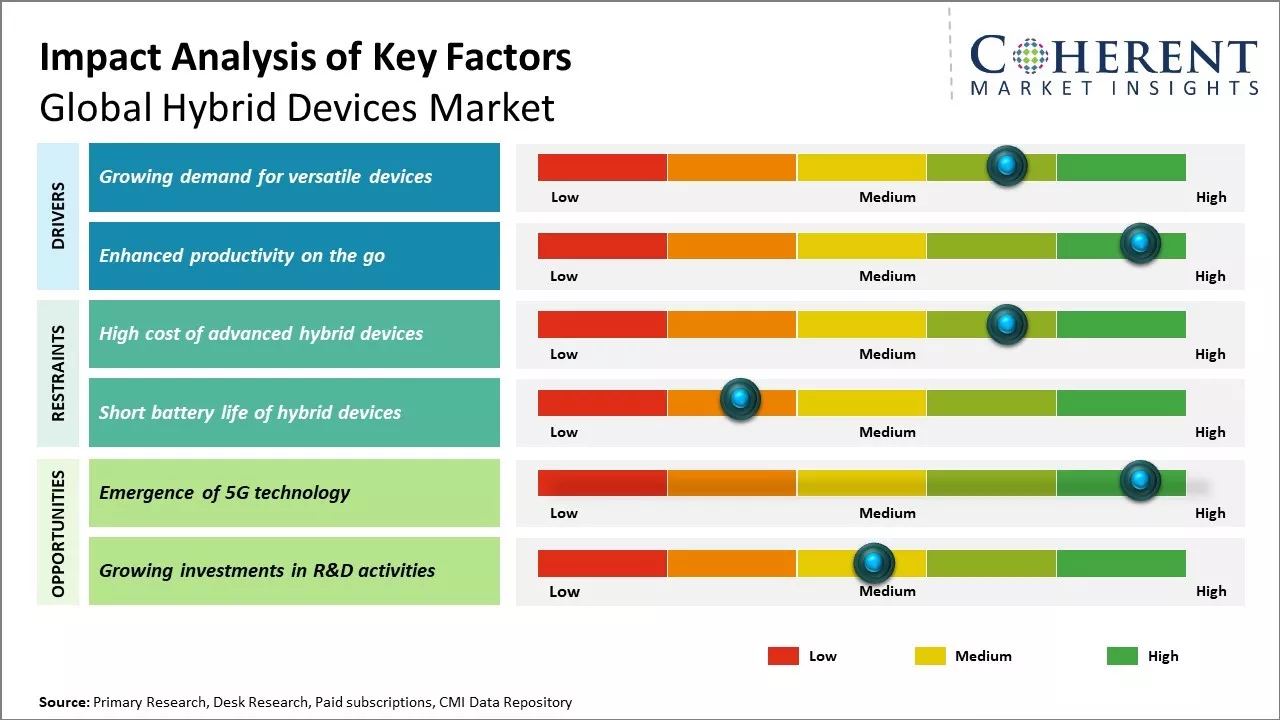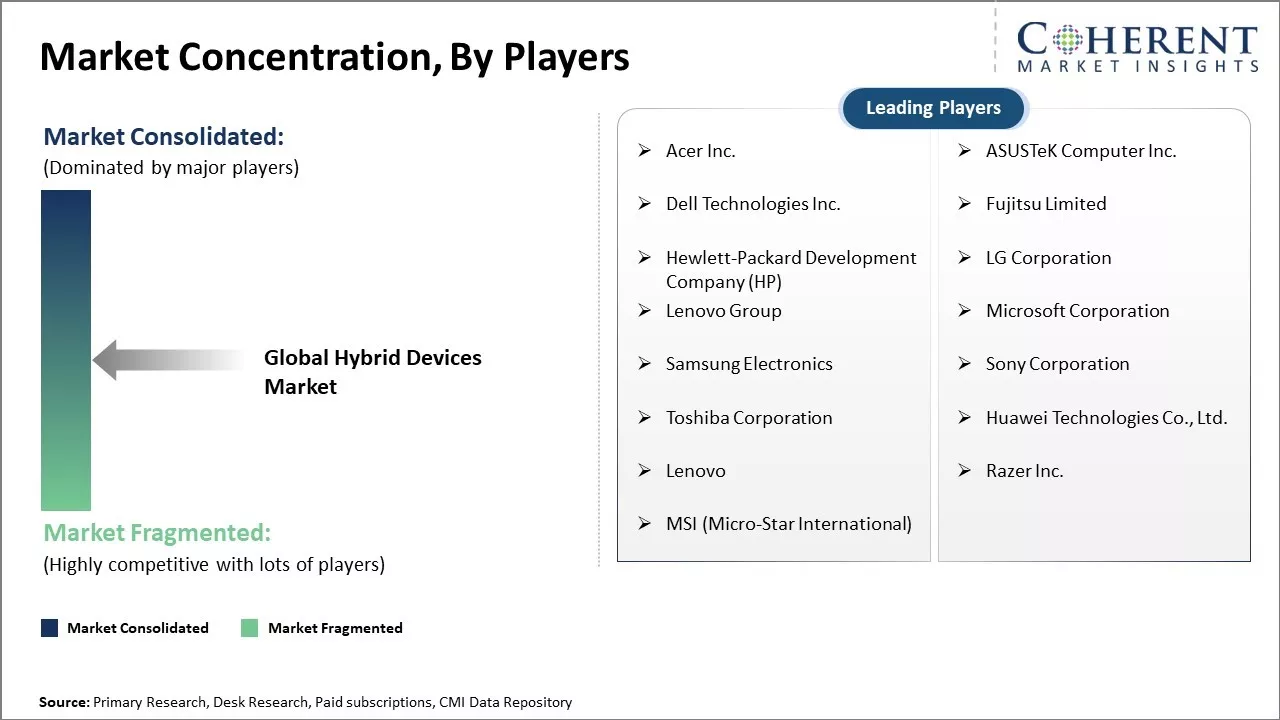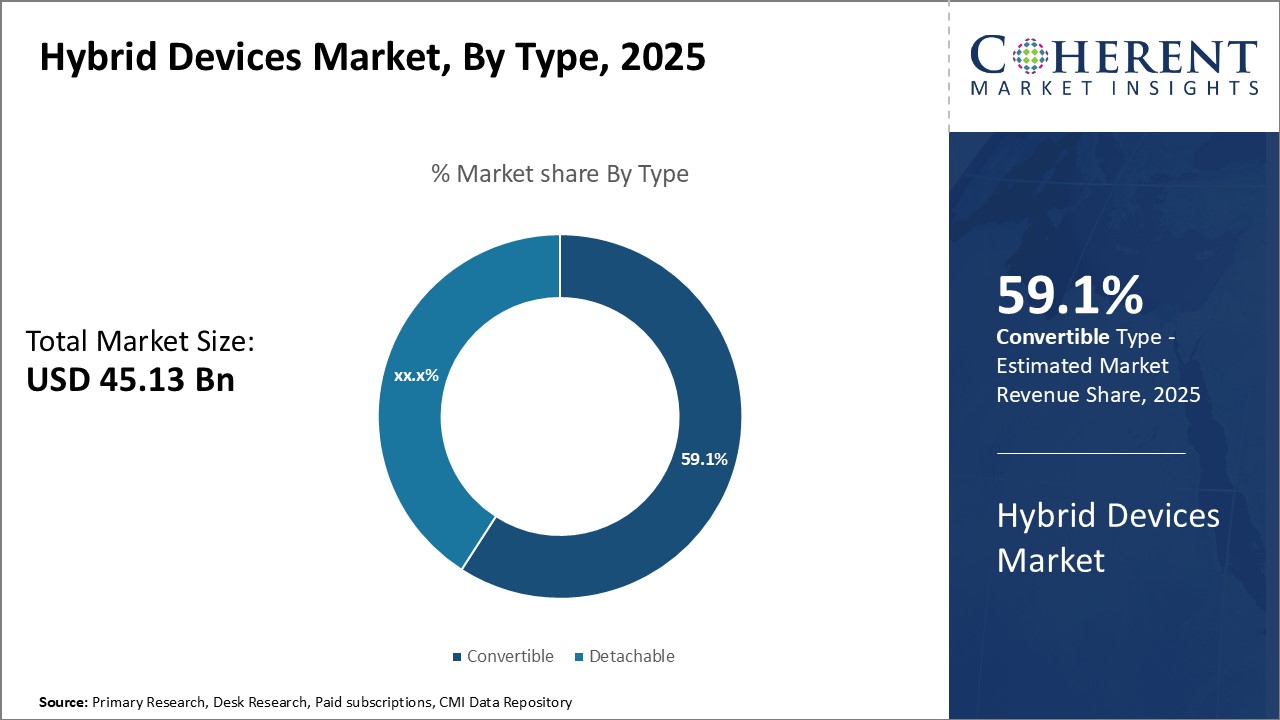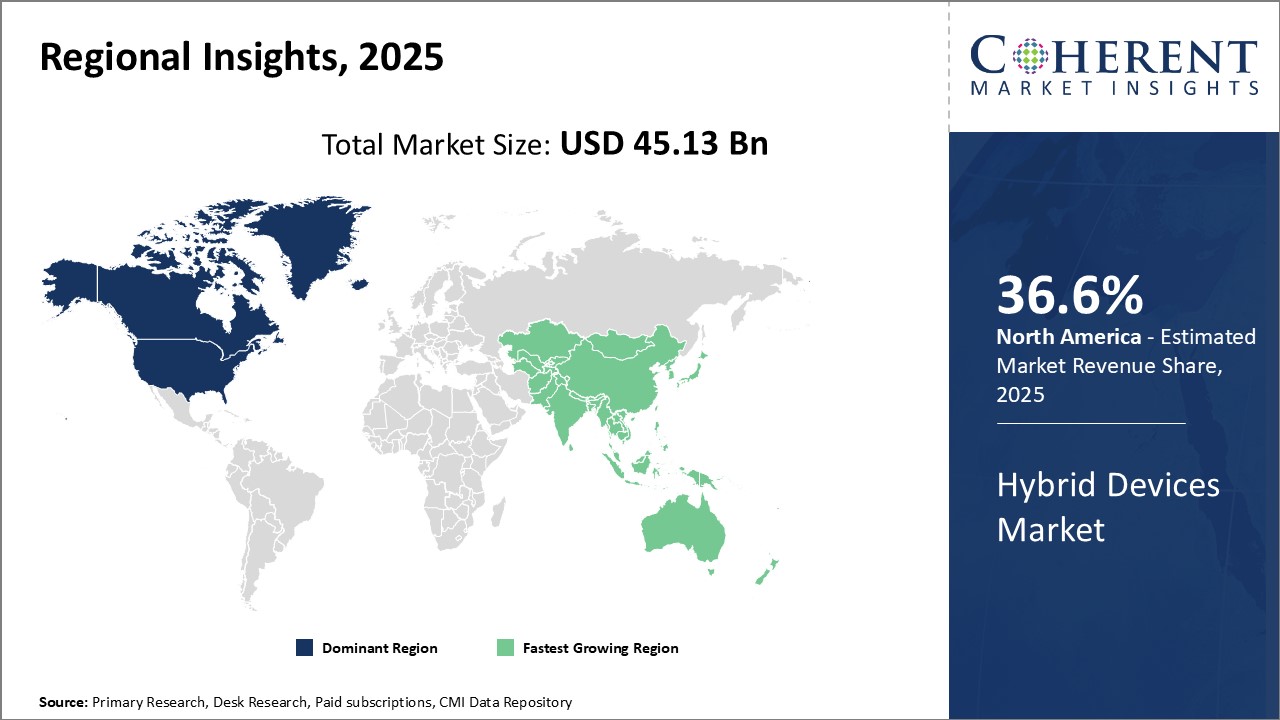The Global Hybrid Devices Market is estimated to be valued at US$ 45.13 Bn in 2025 and is expected to reach US$ 143.84 Bn by 2032, exhibiting a compound annual growth rate (CAGR) of 18.0% from 2025 to 2032.

Discover market dynamics shaping the industry: Download Free Sample
Rising demand for convertible and detachable devices among business enterprises and consumers is a significant factor driving the market growth. These devices offer flexibility of a laptop as well as tablet. Additionally, technological advancement such as touch-screen facilities, lightweight and extended battery life of these products is surging their adoption. Manufacturers are continuously focusing on improving hardware and software functionality of hybrid devices to attract more consumers. Moreover, growing trend of bringing your own device (BYOD) in industries and establishments is further propelling the demand. However, the availability of substitutes like pure laptops and tablets may hinder the market growth to some extent during the forecast period.
Growing demand for versatile devices
The growing consumer demand for versatile devices that can seamlessly switch between tablet and laptop modes is a key driver boosting the global hybrid devices market growth. Traditionally, devices have been optimized for a single mode of operation with hard division between laptops, tablets, and desktops. However, customers today expect more flexibility and capabilities from their electronic gadgets. They want a unified device that can serve both as a tablet for content consumption as well as a laptop for productivity tasks such as creating documents, working on spreadsheets, and making presentations.
Hybrid devices perfectly meet this demand by offering outstanding versatility. With features like 360 degree rotating and detachable touchscreen displays, hybrid PCs allow easy transition between tablet and laptop modes. Users can leverage the touchscreen function for tablet-like activities such as streaming multimedia, gaming, browsing the web, and taking notes. They also get a full-fledged keyboard and computer-like processing power for laptop activities such as creating documents, managing finances, coding, video conferencing and more. Additionally, hybrids provide extended battery life compared to traditional tablets owing to their laptop-grade components. The growing preference for devices that combine the portability of a tablet with productivity capabilities of a laptop continues to drive significant demand for hybrid computers globally.

Get actionable strategies to beat competition: Download Free Sample
Enhanced productivity on the go
Another key driver has been the rising need of mobile professionals and students to stay highly productive while working or studying on the go. Unlike traditional tablets, hybrid devices offer true laptop-level speed, power and functionality even when switched to tablet mode. Users can seamlessly shift between tablet and laptop modes multiple times in a day depending on the task and location, without any lag in processing power. This makes hybrid PCs immensely useful for people who frequently work, learn or collaborate away from their desks. Mobile professionals can create slide presentations, edit documents and manage email directly from the tablet screen during meetings or commute. Students can research for assignments, write papers and annotate e-textbooks on a hybrid device while traveling or attending classes.
The superior processing capabilities and functionality of hybrids ensures users face no compromise in productivity even when away from their main workstations. The lightweight and thin form factor also adds to the convenience. This has boosted uptake of hybrid computers substantially among mobile working professionals in industries like consulting, banking, healthcare as well as students and academicians.
Key Takeaways from Analyst:
Hybrid devices that combine the functionality of laptops and tablets are gaining traction among users who desire mobility along with productivity. The increasing adoption of flexible workstyles is a major driver facilitating the growth of the hybrid devices market. As remote and hybrid work models become more popular, the demand for versatile devices will continue rising.
However, high initial costs of hybrid devices could restraint market growth to some extent. Additionally, quality issues reported by some users related to keyboard typing experience or tablet mode may also slow down the sales momentum. Technological advancements to deliver better user experience could help address such challenges.
North America currently dominates the hybrid devices space due to high consumer spending on premium laptops and tablets. However, Asia Pacific is expected to witness the fastest growth led by increasing sales in China, Japan, and India. As users in developing Asian economies become more quality conscious, hybrid devices will appeal to them as a premium 2-in-1 product.
Manufacturers should capitalize on the opportunities in the education and corporate sectors by customized device designs and bundled subscription offers. There is also scope to offer more detachable keyboard options or stylus support enhance user productivity further. Overall, the hybrid devices concept has the potential to disrupt the separate laptop and tablet markets if key stakeholders address current.
Market Challenges: High cost of advanced hybrid devices
The high cost of advanced hybrid devices is significantly restraining the growth of the global hybrid devices market. Hybrid devices that combine the functionalities of two distinct device categories promise enhanced user experience and capabilities. However, their development and manufacturing involve incorporating hardware and software from two different product lines into a unified system. This results in increased Bill of Materials (BOM) costs for manufacturers compared to conventional devices focusing on a single category. Additionally, achieving optimal integration of disparate hardware and software components from say a smartphone and laptop into a seamless hybrid form factor is technically challenging. Extensive research and development investments are required to ensure reliability of the hybrid design and user experience at par with mainstream dedicated devices.
Market Opportunities: Emergence of 5G technology
The emergence of 5G technology heralds a great opportunity for growth in the global hybrid devices market. 5G offers ultra-fast internet speeds along with low latency which will enable the development of innovative form factors that blend the capabilities of smartphones, laptops and tablets. With 5G, devices will have the processing power and connectivity to support new applications around augmented and virtual reality, artificial intelligence, cloud computing, and internet of things. This will drive demand for hybrid devices that can seamlessly switch between mobile and desktop modes of computing.
Some of the recent trends that showcase immense potential include the rise of foldable and dual-screen devices. Major manufacturers have launched products that can transform from a smartphone into a mini-tablet or devices and offer two interactive displays in single form factor. 5G will allow such novel designs to fulfill their true capabilities with enriched multimedia and multi-tasking experiences. The faster speeds will enable seamless streaming of high-resolution content and running of resource-intensive applications simultaneously across displays. Furthermore, 5G is expected to accelerate the adoption of e-learning worldwide. Hybrid devices leveraging 5G can enhance virtual and blended classroom models by offering versatility of a desktop computer alongside mobility.

Discover high revenue pocket segments and roadmap to it: Download Free Sample
Insights By Type - Portability Boosts Convertible's Market Share
In terms of type, convertible segment is expected to hold 59.1% share of the global hybrid devices market in 2025 due to its portability. Convertible devices offer customers the flexibility to use the device both as a laptop as well as a tablet. This dual functionality allows users to utilize the device in various usage scenarios based on their needs. The convertible form factor proves highly useful for professionals who are constantly on the move and need to switch between traditional laptop tasks such as creating presentations or reports to tablet activities like consuming media or taking notes. Unlike detachable devices, convertibles do not require reattaching the screen and keyboard each time, saving time and effort for mobile users. Their lightweight, seamless design with 360 degree hinges allows smooth transition between modes without hassles. This portable two-in-one format has greatly appealed to mobile workers and students who can easily carry the device everywhere and switch between tasks conveniently on the go.
Insights By Screen Size - Screen Real Estate Boosts 12-15 Inch Segment
In terms of screen size, the 12 inch to 15 inch (12”-15”) segment is expected to hold 39.6% share of the global hybrid devices market in 2025. Screens in this size range provide an ideal balance between portability and productivity. They have enough screen real estate to allow complex multi-tasking and consuming/creating large digital content easily without compromising on the compact form factor. The 12-15 inch screens are large enough for tasks like document editing, graphic design, video conferencing etc. yet small and lightweight enough for constant mobility. This makes the 12-15 inch hybrid devices highly popular among professionals from various industries as well as students and personal users who require a do-it-all on-the-go machine without back pain of large laptops.
Insights By End User - Personal Usage Leads Growth in End User Segment
In terms of end user, the personal use segment is expected to hold 45% share to the global hybrid devices market in 2025 . The pervasive trend of digital transformation has greatly impacted consumer lifestyles and work habits. People now demand devices that can seamlessly blend into both their professional as well as personal lives. Hybrid devices with their versatile two-in-one format perfectly meet this need. Their portable design appeals to users who wish to consumption media or stay connected on social platforms alongside online learning and remote working. Hybrids have become the go-to personal devices, fulfilling requirements from casual entertainment to collaboration and productivity. Their affordable prices have further widened their appeal among cost-conscious users as the ideal all-round companion. This has led the personal usage segment to become the major growth driver in the end user category.

Need a Different Region or Segment? Download Free Sample
The North American region, and especially the U.S. dominates the global hybrid devices market. The region is expected to account for 36.6% of the market share in 2025. This is due to a strong presence of major OEMs like Microsoft, Apple, and Samsung in this region. These companies have established vast production and distribution networks within the U.S. and Canada which enables them to efficiently cater to the large domestic demand. Further, an early adoption of new technologies along with high consumer spending power makes North America one of the most lucrative markets.
Another key reason for the region's dominance is strong industry support from the business and enterprise segment. Hybrids are widely adopted across industries like banking, healthcare, and education due to need for advanced functionality and security in these sectors. Many enterprises are headquartered in the U.S. which has created a robust ecosystem of OEMs, developers, and sellers of tailored enterprise hardware, software, and services. This makes North America the ideal testing ground for specialized business products before their global rollout.
The Asia Pacific market has emerged as the fastest growing regional market for hybrid devices. This growth can be attributed to rapidly increasing disposable incomes, emerging tech-savvy young population and low device penetration levels across many countries in the region like India, Indonesia and Vietnam. OEMs see huge potential in these developing economies and are actively making efforts to introduce more affordable models tailored for these price-sensitive markets.
Additionally, the South East Asian countries serve as important export hubs, with lax regulations and availability of cheap labor driving local assembly and manufacturing. As a result, hybrids produced in the region can be exported globally at competitive rates. Countries like China and India have developed into key manufacturing bases for major brands. This strong production presence, coupled with growing domestic demand, makes South East Asia an important contributor to the global hybrid devices market volume in the coming years.
Hybrid Devices Market Report Coverage
| Report Coverage | Details | ||
|---|---|---|---|
| Base Year: | 2024 | Market Size in 2025: | USD 45.13 Bn |
| Historical Data for: | 2020 To 2024 | Forecast Period: | 2025 To 2032 |
| Forecast Period 2025 to 2032 CAGR: | 18.0% | 2032 Value Projection: | USD 143.84 Bn |
| Geographies covered: |
|
||
| Segments covered: |
|
||
| Companies covered: |
Acer Inc., ASUSTeK Computer Inc., Dell Technologies Inc., Fujitsu Limited, Hewlett-Packard Development Company (HP), LG Corporation, Lenovo Group, Microsoft Corporation, Samsung Electronics, Sony Corporation, Toshiba Corporation, Huawei Technologies Co., Ltd., Lenovo, and Razer Inc., MSI (Micro-Star International) |
||
| Growth Drivers: |
|
||
| Restraints & Challenges: |
|
||
Uncover macros and micros vetted on 75+ parameters: Get instant access to report
*Definition: The Global Hybrid Devices Market consists of any electronic devices that combine functionality of both hardware devices and software applications into a single unit. This includes devices with features of traditional computers along with touchscreens for interactive use like tablets. Other examples include phones that can be folded out into small tablets or laptops. These hybrid devices provide versatile, multifunctional capabilities to users on the go.
Share
Share
About Author
As an accomplished Senior Consultant with 7+ years of experience, Pooja Tayade has a proven track record in devising and implementing data and strategy consulting across various industries. She specializes in market research, competitive analysis, primary insights, and market estimation. She excels in strategic advisory, delivering data-driven insights to help clients navigate market complexities, optimize entry strategies, and achieve sustainable growth.
Missing comfort of reading report in your local language? Find your preferred language :
Transform your Strategy with Exclusive Trending Reports :
Frequently Asked Questions
Joining thousands of companies around the world committed to making the Excellent Business Solutions.
View All Our Clients